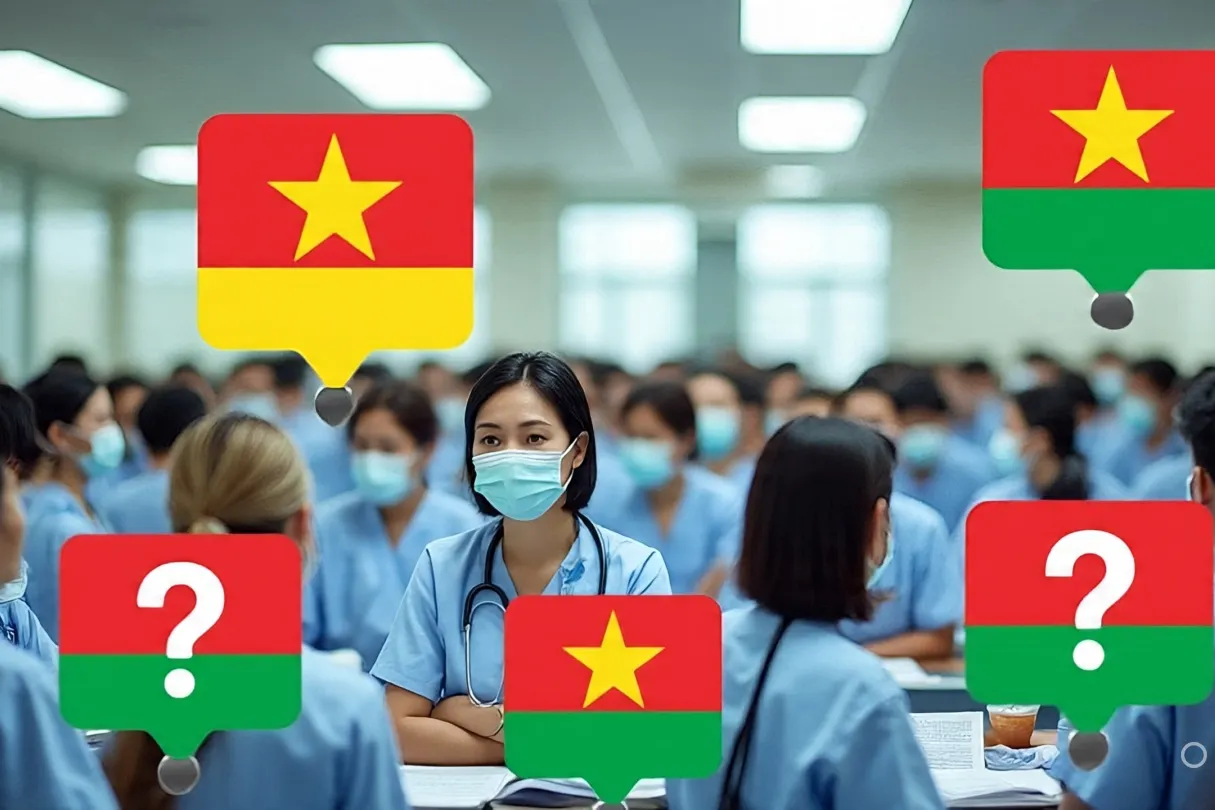Vietnam was initially lauded for its seemingly successful early response to the COVID-19 pandemic, boasting remarkably low infection and mortality rates in the initial waves. However, the devastating Delta variant surge in 2021 painted a starkly different picture, overwhelming healthcare systems and leading to a significant increase in reported deaths. Yet, even amidst this crisis, a persistent and troubling claim began to circulate, fueled by whispers, social media speculation, and a deep-seated skepticism towards the centralized government’s information control: that Vietnam drastically underreported its COVID-19 death toll, particularly during the peak of the Delta wave.
- 🧠 The Birth of Suspicion: Censorship and Social Media
- 📊 Comparing Reporting Practices: Vietnam and ASEAN
- 🗣️ Voices and Perspectives: A Range of Experiences
- 🏛️ The Role of Information Control: Fueling the Fire
- ✅ Evidence-Based Review: Verified Data and Expert Assessments
- ✨ Navigating Doubt and Seeking Truth
This theory isn’t merely academic conjecture. It touches upon sensitive issues of public trust, government transparency, and the very human tragedy of loss during a global health crisis. For many Vietnamese citizens and members of the diaspora, the official figures simply didn’t align with the anecdotal evidence of widespread illness and overflowing crematoriums. The tightly controlled media environment and the inherent limitations on independent reporting further amplified these doubts, creating a fertile ground for speculation. To understand the validity of these claims, we must delve into the origins of the rumors, examine Vietnam’s reporting practices, compare them with regional peers, and critically assess the available evidence from independent international organizations.
🧠 The Birth of Suspicion: Censorship and Social Media
The suspicion surrounding Vietnam’s COVID-19 data has several intertwined roots:
🔒 Strict Government Information Control
Vietnam operates under a one-party system with tight control over media and information dissemination. This centralized control, while often credited with facilitating the early pandemic response through swift public health messaging and containment measures, also creates an environment where independent scrutiny and dissenting voices are limited. During the Delta wave, as the situation on the ground became increasingly dire, reports of overwhelmed hospitals and rising fatalities often seemed at odds with the official daily case and death counts released by the Ministry of Health. This discrepancy naturally bred suspicion and fueled the belief that the government was intentionally downplaying the severity of the crisis.
📱 The Role of Social Media and Unverified Accounts
In the absence of freely reported news, social media platforms became a primary, albeit often unreliable, source of information for many Vietnamese citizens. Witness accounts, personal stories of loss, and unverified claims of significantly higher death tolls than officially reported spread rapidly. While these platforms offered a space for individuals to share their experiences, they also became breeding grounds for misinformation and speculation, making it difficult to discern fact from rumor. The sheer volume of anecdotal reports of loss and suffering contributed to a widespread feeling that the official numbers were not telling the full story.
🗺️ Comparisons with Regional Countries
Observing the experiences of neighboring ASEAN countries during the Delta wave also contributed to the skepticism. Nations like Indonesia, Thailand, and the Philippines, which generally have a more open media landscape, reported significantly higher death tolls relative to their population sizes during similar periods. While direct comparisons are complex due to varying testing capacities, demographics, and healthcare systems, the stark differences in reported mortality rates raised questions about the accuracy of Vietnam’s data in the eyes of some observers.
📊 Comparing Reporting Practices: Vietnam and ASEAN
Understanding Vietnam’s COVID-19 reporting practices requires a comparison with its regional counterparts. Factors to consider include:
- Testing Capacity and Criteria: The availability and criteria for COVID-19 testing significantly impact the number of confirmed cases and, consequently, the reported death toll. Differences in testing strategies across countries can lead to variations in the detection of milder cases and deaths indirectly related to the virus.
- Cause of Death Certification: The process for determining and certifying the cause of death can vary. Some countries may have more stringent criteria for attributing a death directly to COVID-19, while others may include deaths where COVID-19 was a contributing factor.
- Data Aggregation and Reporting Systems: The efficiency and sophistication of data collection and reporting systems can influence the timeliness and accuracy of official statistics. Differences in these systems across ASEAN nations may contribute to variations in reported numbers.
- Transparency and Access to Data: The level of publicly available data and the extent to which international organizations have access to verify these data also play a crucial role in building confidence in official statistics.
While some ASEAN nations provided more granular data and faced less stringent media control than Vietnam, drawing definitive conclusions about underreporting based solely on comparisons is challenging due to these inherent differences in reporting methodologies and socio-political contexts.
🗣️ Voices and Perspectives: A Range of Experiences
Gathering perspectives from various stakeholders provides a more nuanced understanding of the situation:
🩺 Public Health Experts: Challenges and Limitations
Public health experts acknowledge that accurately tracking deaths during a pandemic, especially during a surge that overwhelms healthcare systems, is a significant challenge globally. In the context of Vietnam, they might point to:
- Limited testing capacity during peak surges: Prioritizing testing for symptomatic individuals may have led to an undercounting of milder cases and potentially some COVID-related deaths outside of hospital settings.
- Strain on healthcare infrastructure: Overwhelmed hospitals may have faced difficulties in accurately documenting all cases and causes of death.
- Focus on controlling the spread: The government’s primary focus on containment measures might have, at times, overshadowed the detailed collection and dissemination of mortality data.
However, they also emphasize the potential for political influence on data reporting in centralized systems and the importance of independent verification.
🇻🇳 Vietnamese Citizens: Anecdotal Evidence and Grief
Many Vietnamese citizens who lived through the Delta wave share personal stories of loss and widespread illness that seemed far greater than the official numbers suggested. Accounts of overflowing hospitals, long queues at crematoriums, and the sheer number of families mourning loved ones contributed to a sense that the true scale of the tragedy was being downplayed. This anecdotal evidence, while deeply personal and impactful, is not a substitute for systematic data but reflects a genuine public perception of a higher death toll.
🌍 Diaspora Perspectives: Mistrust and Calls for Transparency
Members of the Vietnamese diaspora often express stronger skepticism towards the official data, citing the government’s history of information control and a perceived lack of accountability. They frequently share social media reports and call for greater transparency and independent investigation into the actual number of COVID-19 related deaths. Their perspective is often shaped by a broader distrust of the communist government and a desire for a more open accounting of the pandemic’s impact.
🏛️ The Role of Information Control: Fueling the Fire
Vietnam’s centralized government’s tight grip on information undeniably contributed to the environment of suspicion surrounding the COVID-19 death toll. The lack of independent media scrutiny and the suppression of dissenting voices can erode public trust in official statistics, especially during a crisis where accurate and timely information is crucial. While the government likely aimed to maintain social stability and public confidence through its messaging, the limitations on transparency inadvertently fueled rumors and conspiracy theories about the true extent of the pandemic’s impact.
The absence of robust mechanisms for independent verification of mortality data further compounded the issue. Without the ability for external organizations or journalists to freely investigate and report on the situation, the official numbers remained the sole source of information, leading to skepticism among those who felt they contradicted their lived experiences.
✅ Evidence-Based Review: Verified Data and Expert Assessments
Despite the rumors and suspicions, assessing the claim of drastic underreporting requires examining the data verified by independent international organizations.
🌎 World Health Organization (WHO) Data
The World Health Organization has been working with countries globally to track COVID-19 cases and deaths. While the WHO acknowledges the challenges in obtaining perfectly accurate mortality data during a pandemic, their assessments of Vietnam’s reported figures, while noting potential limitations in early phases due to testing capacity, have not pointed to a deliberate and massive underreporting of deaths during the Delta wave that would fundamentally alter the understanding of the pandemic’s impact in the country. The WHO’s data relies on official figures provided by the Vietnamese Ministry of Health, but they also engage in ongoing dialogue and verification processes with member states.
🤝 NGO and Independent Analysis
Several non-governmental organizations and independent research groups have analyzed COVID-19 mortality data globally. While some have pointed to potential underreporting in various countries due to factors like limited testing or overwhelmed healthcare systems, there is no widespread consensus or strong evidence suggesting that Vietnam’s underreporting was significantly more severe or deliberately concealed on a massive scale compared to other nations with similar resource constraints during the Delta surge. Some studies have indicated potential undercounting, particularly in the early stages of the pandemic before widespread testing was available, but these estimates are within a plausible range considering the challenges faced by healthcare systems globally.
🔬 Serological Surveys and Excess Mortality Studies
Looking at excess mortality – the number of deaths above what would be expected based on historical trends – can provide a broader picture of the pandemic’s impact, including deaths not directly attributed to COVID-19. While comprehensive excess mortality data for Vietnam during the Delta wave is somewhat limited in publicly available sources, existing analyses do not indicate a massive discrepancy that would definitively prove a vast, intentional underreporting of direct COVID-19 deaths. More detailed serological surveys, which look for antibodies in the population to estimate the true infection rate, could offer further insights into the overall impact of the virus, but these do not directly address the cause of death reporting.
✨ Navigating Doubt and Seeking Truth
The claim that Vietnam drastically underreported its COVID-19 death toll, particularly during the Delta wave, is a complex issue rooted in a confluence of factors: the inherent challenges of pandemic data collection, the limitations of a tightly controlled information environment, and the deeply personal experiences of loss and suffering. While anecdotal evidence and comparisons with regional neighbors fueled suspicion, a comprehensive review of data verified by international organizations like the WHO and available independent analyses does not definitively support the theory of a massive, deliberate underreporting of deaths that fundamentally distorts the scale of the tragedy.
It is crucial to acknowledge the genuine grief and mistrust felt by many Vietnamese citizens and members of the diaspora. Enhancing transparency in data collection and reporting, fostering greater independent scrutiny, and building public trust in official information are essential steps for any government navigating a public health crisis. While the shadow of doubt surrounding Vietnam’s COVID-19 data may linger for some, the available evidence suggests that while some degree of undercounting, common in many nations during peak surges, likely occurred, there is no credible proof of a vast, intentional cover-up of mortality figures on a scale that would fundamentally change our understanding of the pandemic’s impact in Vietnam. The true narrative likely lies in the complexities of a rapidly evolving crisis, the limitations of data collection in overwhelmed systems, and the enduring need for greater transparency and open communication between governments and their citizens.




